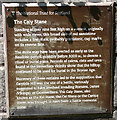Commemorated on 1 plaque
The National Trust for Scotland. The Caiy Stone. Standing at over nine foot high on a summit, originally with wide views, this broad slab of red sandstone includes a line of six, probably prehistoric, cup marks on its reverse face. The stone may have been erected as early as the Neolithic period, possibly before 3000 BC, to denote a ritual or burial place. Records of cairns, cists and urns found in the immediate vicinity show that the hilltop continued to be used for burial in the Bronze Age. Discovery of these remains led to the supposition that Caiyside Hill was the site of a battle, variously suggested to have involved invading Romans, Danes (Vikings); or Cromwellians. The Caiy Stone, also known as the Kel Stane, the Cat Stane or the Camus Stane, was thought to have been a battle memorial stone.
, Edinburgh, United Kingdom where it sited
